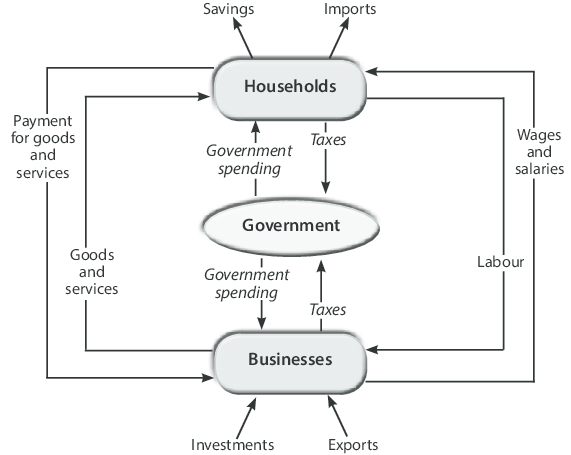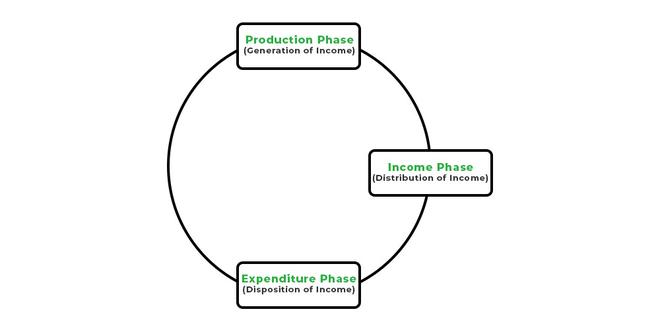The principal of 3-sided national income
Part 1. real goods, employment, and business management indicator
the principal of 3-sided national income
The principle of the three approaches to national income equivalence states that Gross Domestic Product (GDP) can be measured from three perspectives: production, income, and expenditure, and the values obtained from each perspective should be equal. This principle is also known as the three faces of national income equivalence and is an important concept in economics for measuring and analyzing economic activity within a country.
Production Approach:
- In this perspective, the value of goods and services produced within the domestic economy is measured. It involves summing up the value of all goods and services produced by various industries and sectors. This approach helps calculate GDP by assessing the total value produced domestically.
Income Approach:
- The income approach measures how the value generated domestically is distributed among various factors such as wages, interest, rent, and profits. It provides insights into how income is earned and distributed within the economy. Using this approach, GDP can be measured by summing up the various components of income.
Expenditure Approach:
- The expenditure approach focuses on how the value of goods and services produced domestically is spent. It includes categories such as personal consumption, business investment, government spending, and exports. GDP can be calculated by summing up the total expenditures within the economy.
The principle of the three approaches to national income equivalence requires that the GDP values obtained from these three different perspectives should be equal. This ensures that the measurement of economic activity within a country is consistent and allows for a comprehensive understanding of the economy from various angles. It is a crucial principle for both assessing economic performance and formulating economic policies.
Production GDP / distribution GDP / expenditure GDP
This is an explanation of GDP measurement within a country. GDP stands for Gross Domestic Product, and it is a crucial indicator that represents the total value of all goods and services produced in a country during a specific period.
- Production GDP:
Production GDP represents the total value of all goods and services produced within a country. This value is calculated by summing up the value of everything produced across all industries and sectors.
- Expenditure GDP:
Expenditure GDP represents the total value of goods and services produced that are purchased and used through household consumption, business investments, government spending, and foreign sector expenditures. It includes categories such as consumption, investment, government expenditure, and exports, illustrating how economic agents buy and use goods and services.
- Income GDP:
Income GDP reflects the compensation or payment for the production factors used in economic activities, including labor, capital, and capital income. The value-added generated through production activities is distributed among economic agents, indicating the rewards for their contributions to production.
- Key Points:
Production GDP and expenditure GDP should be equal in size because all goods and services produced are purchased and used by economic agents.
Production GDP and income GDP should also be equal because the value-added created through production is distributed to the economic agents providing production factors.
These three methods of measuring GDP provide insights into economic activity from different perspectives, helping to understand and analyze a country’s economic condition and formulate economic policies.
Principle of 3-sided equivalent of national income in terms of GDP in Korea
The principle of the three approaches to national income equivalence is evident in South Korea’s GDP measurement, which encompasses production, income, and expenditure perspectives. Let’s examine South Korea’s GDP using these perspectives. It’s important to note that South Korea places a strong emphasis on the production approach for GDP measurement, making Gross Domestic Product (GDP) based on production activity the central reference point.
Production Perspective :
- In the production perspective, GDP is calculated by evaluating the value-added for economic activities across different sectors. It includes both the value of goods and services produced and the net production tax (production tax minus production subsidies).
- In 2017, South Korea’s GDP from the production perspective was 1,730.4 trillion won. This GDP was composed of contributions from sectors like manufacturing (477.1 trillion won) and services (914.4 trillion won).
Gross domestic product(Market price) = Value added by economic activity(Base price) + Net product tax(Product tax – Product subsidy)
2. Income Perspective :
- The income perspective of GDP looks at how the income generated from economic activities is distributed among various economic agents. It includes wages and salaries paid to labor, operating surplus for business owners, depreciation of fixed capital, and net production and income taxes.
- In 2017, South Korea’s GDP from the income perspective was also 1,730.4 trillion won. It included wages and salaries (767.6 trillion won), operating surplus (449.2 trillion won), depreciation (331.7 trillion won), and net production and income taxes (181.9 trillion won).
Gross domestic product = Employee remuneration + operating surplus + fixed capital consumption + net production tax and import tax
3. Expenditure Perspective :
- The expenditure perspective of GDP considers the total spending by economic agents, including households, businesses, government, and the foreign sector. It encompasses private consumption, government consumption, fixed capital formation, changes in inventory, exports, and imports.
- In 2017, South Korea’s GDP from the expenditure perspective was also 1,730.4 trillion won. It included components such as private final consumption expenditure (832.2 trillion won), government final consumption expenditure (265.3 trillion won), gross fixed capital formation (538.5 trillion won), changes in inventory (-0.8 trillion won), exports of goods and services (745.6 trillion won), and imports of goods and services (652.2 trillion won).
Gross domestic product = private final consumption expenditure + government final consumption expenditure + total fixed capital formation
+ Inventory Increase + Export – Import + Statistical Mismatch
| Perspective | GDP (Trillion Won) |
|---|---|
| Production | 1,569.0 |
| - Agriculture, Forestry, and Fishing | 34.0 |
| - Mining and Manufacturing | 479.9 |
| - Electricity, Gas, and Water Supply | 47.5 |
| - Construction | 93.2 |
| - Services | 914.4 |
| - Total Value Added | 1,569.0 |
| Income | 1,730.4 |
| - Compensation of Employees | 767.6 |
| - Operating Surplus | 449.2 |
| - Depreciation | 331.7 |
| - Net Production and Income Taxes | 187.3 |
| - Total Income | 1,730.4 |
| Expenditure | 1,730.4 |
| - Private Final Consumption Expenditure | 832.2 |
| - Government Final Consumption Expenditure | 265.3 |
| - Gross Fixed Capital Formation | 538.5 |
| - Changes in Inventory | -0.8 |
| - Exports of Goods and Services | 745.6 |
| - Imports of Goods and Services | 652.2 |
| - Total Expenditure | 1,730.4 |














